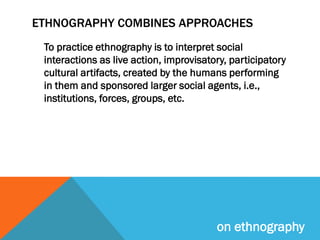On ethnography
- 2. WRITING IS MATERIAL: on ethnography
- 3. WRITING IS MATERIAL: : physical. . . . on ethnography
- 4. WRITING IS MATERIAL: : physical, historical. . . . on ethnography
- 5. WRITING IS MATERIAL: : physical, historical, and social. on ethnography
- 6. SO FAR WE’VE PRACTICED . . . . . . the interpretation of artifacts. . . . on ethnography
- 7. SO FAR WE’VE PRACTICED . . . . . . the interpretation of artifacts and the writing of history. on ethnography
- 8. ETHNOGRAPHY COMBINES APPROACHES on ethnography on ethnography
- 9. ETHNOGRAPHY COMBINES APPROACHES To practice ethnography is to interpret social interactions as live action, improvisatory, participatory cultural artifacts, created by the humans performing in them and sponsored larger social agents, i.e., institutions, forces, groups, etc. on ethnography
- 10. ETHNOGRAPHY AND MODERNITY: Colonialism, the “New World,” and the Rise of the Social sciences on ethnography
- 11. ETHNOGRAPHY AS A GENRE OF WRITING: Thick description + close reading. on ethnography
- 12. LET’S PRACTICE! The Driscoll Bridge as cultural artifact: • Who are the “performers”? • What are they doing, alone and with one another? • What are the pertinent elements of the setting? • What larger social agents are sponsoring the “performance”? • What does the performance mean, i.e., what does it tell us about how and why the “performers” interact with one another and their “sponsors” in the way that they do? on ethnography












